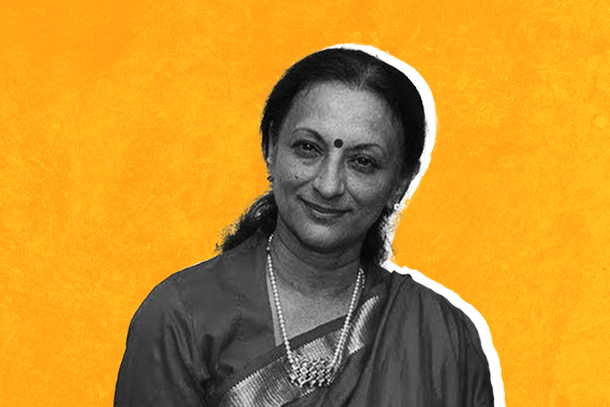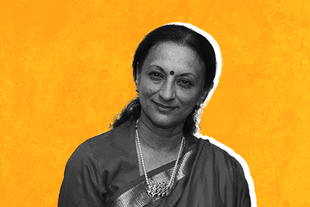Obit
Uma Ramanan: She Added Extra Dignity To Dignified Songs Of A Musical Era
K Balakumar
May 02, 2024, 03:27 PM | Updated 03:27 PM IST
Save & read from anywhere!
Bookmark stories for easy access on any device or the Swarajya app.


It was circa 2004. Uma Ramanan, the singer who passed away yesterday (1 May) at the age of 69, was at a concert held under the aegis of the music troupe Musiano, run by her singer husband Ramanan.
Uma's peak playback singing days were behind her then. But she was still in good singing form, and in that concert she uncorked quite a few of the melodies that made her a popular voice all through the 1980s and 1990s.
A bunch of college folks who were at the show, impressed by Uma's singing and pitch-preciseness, hung around the green room to get her autograph. A bunch of us journos who were at the concert buttonholed the college students on what stood out for them in her singing.
"She hardly looked like singing. The face showed no emotion and there was no movement in her body, while she stood focused on just singing," a youngster said. "She was full of poise and dignity."
Yes, dignity is the word that one would naturally associate with Uma Ramanan, both in her playback singing and her performance on stage. It was a quality that defined all through her long career, which began in 1977 and ran till the 2010 (her film playback though practically ended in 2005 with Thirupachi). She brought to her songs what she brought to the stage.
Uma, born into a traditional Brahmin family, like many girls of that era, learnt both classical Carnatic music and Bharatanatyam. It was an inevitable rites of passage of growing up then.
A chance encounter with Ramanan, who was then starting out on his own with a music troupe, helped Uma to become a stage singer.
In the mid-1970s, Ramanan's troupe with Uma being the female lead singer was quite a rage in Tamil Nadu, and Tamil magazines then were filled with glowing reviews of their show.
Ramanan and Uma, who had become a pair in life too, were praised for spontaneous singing. It was a question of only a matter of time before they got their break as film playback singers.
A Break, But Not Much Headway
Ramanan was flamboyant while Uma, typically, was restrained, and they worked well as a combo. And their first film offer came for a duet in a Hindi film with a name that one wouldn't associate with her personality — Play Boy.
This 1976 movie had music by the duo Sonik-Omi (who were once understudies to Madan Mohan and Roshan) and was directed by T Janakiram, who was the one responsible for blooding Uma and Ramanan as singers in the film.
The song Hai Ek Buddhu Chhora did not make much impact. It was a wannabe song with Uma singing in Lata vein and Ramanan doing a Kishore Kumar reprise.
After the initial breakthrough, the duo did not find the going great as offers were hard to come by. In 1977, music director S V Venkatraman gave them their first song in Tamil in the A P Nagarajan-helmed Sri Krishna Leela. The duet in the duo's voices, Mohana Kannan Murali Kandhan again did not create any splash.
As chances were unavailable, Ramanan, who was considered limited as he was more at home imitating SPB or Kishore Kumar, decided to try his luck as a music director. Ramanan managed to land himself a film as a composer. In that film Neerottam (1980), Ramanan and Uma again belted out a duet Aasai Irukku.
Though not a big hit, this song showed Uma's voice had a unique character and can withstand the rigours of playback singing. But in that period, to make it as a film singer, one had to be fortunate to be chosen by Ilaiyaraaja. And luckily for Uma, the great music director was impressed with what he heard from Uma (as a track and chorus singer).
Uma And Ilaiyaraaja Partnership Belonged To Musical Heaven
Uma's breakthrough appropriately happened under his baton with two songs in two films that released on the same day (6 November 1980). Nizhalgal and Moodu Pani.
The Nizhalgal number Poongathave Thal Thiravai is now a hall of famer, a song that is part of Uma's singing lore. It was, in Mayamalavagowla ragam, in her zone.
But Aasai Raja, a lilting and haunting lullaby of sorts, called for different skills. The song needed emotional gravitas, and the relatively inexperienced Uma was up to the challenge. It underscored the fact that she was ready for the big league.
The songs that she sang for Ilaiyaraaja for over a decade though less in number (in comparison to what the biggies like Janaki, Susheela, K S Chitra and Vani had) are, however, unique and will be remembered for their tune, orchestration and also for Uma's ability to deliver the sangathis unfussily.
The three songs she got in 1981 from Ilaiyaraaja would have been dream-come-true for any singer.
The remarkable Aanada Raagam (Panneer Pushpangal), which can probably play on loop in her grave, was just the start that year. The way Uma hit the high notes of the Simmendra Mathyama of Ananda Ragam after the effulegent brilliance of violins and flute is now stuff of Tamil film music legend.
Then there was the ethereally pleasant Manjal Veyil Malai Itta Poove in Nandu and the classically beautiful Amudhae Thamizhae in Kovil Pura in tandem with P Susheela.
Interestingly, all through her career, Uma sang quite a few songs with other female singers. It showed the confidence of music directors that she will hold herself fine amidst the challenge of others.
Uma And Her Duets With Other Female Singers
In 1981 itself, she had the song Kalviyil Saraswati in Kudumbam Oru Kadambam under M S Vishwanathan, which also had the voices of Vani Jairam, S P Sailaja and B S Sasirekha.
Then there was this extraordinarily soothing Thalampoove Kannurangu in that musically sensational Indru Nee Naalai Naan, and Uma was again at ease in the company of Janaki and SPB.
In 1986, Uma had a reverberating duet, Pala Pala, with Shoba Chandrasekhar in Kodai Mazhai. It is an underrated beauty, full of bounce and energy in voices filled with youthful energy.
With Chitra, Uma had duets in films like Mallu Vetti Minor (1990) and Pudhu Nellu Pudhu Naathu (1991). With Minmini, she had the song Kanmanikul Chinna Chinna in Chinna Mapillai (1993).
Alongside Swarnalatha, the enormously sensuous Ooradangum Samathile (in Pudupatti Ponnuthayi 1994), and the compact Poo Choodum (in Aanazhagan 1995).
And the songs with other female singers can be rounded off with one true chart-buster. The Sri Ranga Ranganathanin in Mahanadhi (1994).
Just consider this fact. All of these songs were for Ilaiyaraaja, who had great faith in her talent. It is arguable whether any other singer had so many duets with her competitors. Beneath the quiet demeanour of Uma there was a very confident singer who was not afraid of challenges of any type.
These Are Musical Gems
Among the male singers too, she has sung with every one of them. With SPB, Uma has the most number of songs. The Yar Thurigai Thandha Oviyam in the little known Paru Paru Pattanam Paru (1986) has to be among the best.
The Poothu Poothu Kulunguthadi in Kumbakarai Thangaiah (1991) is not far behind. The catchy Velli Nilave in Nandhavana Theru (1995) Velli Nilave Velli Nilave has committed followers to this day.
The exuberant Elalam Kuyiley Elemara in Paandi Nattu Thangam (1989) is another eternal crowd-pleaser, so is Unna Partha Nerathula with Malaysia Vasudevan (Mallu Vetti Minor).
Uma’s Best Was With Yesudas
But some of the biggest hits of Uma’s career came in tandem with K J Yesudas. You had to merely list out them without having to say anything about them, as such is their popularity that nothing new can be added.
Her first song with the great KJY was Vaaname Mazhai Megame (the unheralded Madhu Malar 1981). The next is the unforgettable melody of Bhoopalam Isaikkum (Thooral Ninnu Pochu 1982).
The song is an exemplar of why the Uma-KJY combination worked so beautifully. His heavy and sonorous voice is the easy counterpoint to the natural lilt of Uma. You can listen to this song all day and not feel bored, such is its freshness.
The discoish Aathadi Athisayam in Manaivi Solle Manthiram (1983) is another example of how these two voices can blend seamlessly at the hands of an inventive music director.
Listen to this sober Thaagame Undaanathe in the film Ketti Melam (1985) and you will know that a standard romance number can be tuned without cinematic musical cliches. The reflective Oh Vaanam Ulla Kaalam in that unknown Puthiya Swarangal (1992) is another hidden gem of the duo.
The KJY-Uma combo's acme was seen in Kasthoori Maane (Pudhumai Penn 1984), Ponn Maanae Kovam Eno (Oru Kaidhiyin Diary 1985), Kanmani Nee Vara (Thendrale Ennai Thodu 1985) and Kuyile Kuyile (Pulan Visaranai 1990).
But the biggest ones from the duo have to be Nee Pathi Naan Pathi Kanne (Keladi Kanmani 1990) and the sensational Kaandaish Aagaya Vennilave (Arangetra Velai 1990). They well and truly belong to the highlights package of music of 1990. The two singers enriched the music of that music-rich era.
It is a pity that almost all her best songs came for Ilaiyaraaja. That other music directors did not use her talent as much is not her loss. Towards the end of her career, she did sing for the likes of Mani Sharma and Vidyasagar. But those were far and few between.
Also, her voice, with a strong base, belonged to the Tamil milieu, and hence she sang hardly anything outside of her mother language (though in stage concerts she did perform songs in other languages).
Uma's singing had a bit of Susheela and Sailaja, as her voice was both sweet, strong, and sharp. An understated sadness added an extra attraction to her voice. She never overtired, and her singing had an enviable evenness.
The emotions that she brought to a song fit it to a T — and that is perhaps why she was Ilaiyarajaa's favourite. He is a music director who believes in singers who deliver what the song he has composed needs. Damn the showmanship.
Uma knew her strengths as well as limitations, and was a contented singer. And that is the feeling that you as a listener got from her. In a sense, that is the purpose of music. Uma's life had both purpose and music.





